英国概况Unit 1
- 格式:doc
- 大小:85.50 KB
- 文档页数:8
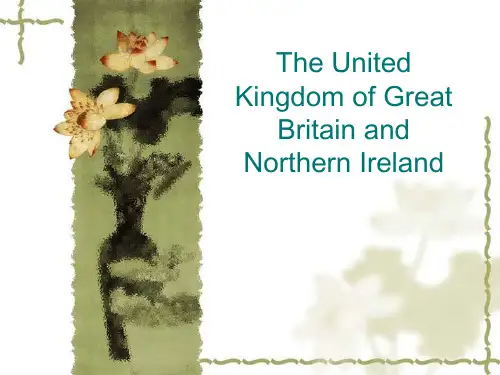
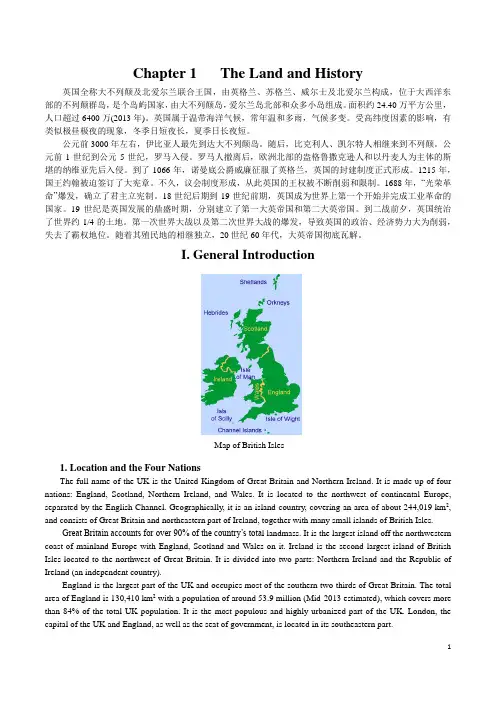
Chapter 1 The Land and History英国全称大不列颠及北爱尔兰联合王国,由英格兰、苏格兰、威尔士及北爱尔兰构成,位于大西洋东部的不列颠群岛,是个岛屿国家,由大不列颠岛,爱尔兰岛北部和众多小岛组成。
面积约24.40万平方公里,人口超过6400万(2013年)。
英国属于温带海洋气候,常年温和多雨,气候多变。
受高纬度因素的影响,有类似极昼极夜的现象,冬季日短夜长,夏季日长夜短。
公元前3000年左右,伊比亚人最先到达大不列颠岛。
随后,比克利人、凯尔特人相继来到不列颠。
公元前1世纪到公元5世纪,罗马入侵。
罗马人撤离后,欧洲北部的盎格鲁撒克逊人和以丹麦人为主体的斯堪的纳维亚先后入侵。
到了1066年,诺曼底公爵威廉征服了英格兰,英国的封建制度正式形成。
1215年,国王约翰被迫签订了大宪章。
不久,议会制度形成,从此英国的王权被不断削弱和限制。
1688年,“光荣革命”爆发,确立了君主立宪制。
18世纪后期到19世纪前期,英国成为世界上第一个开始并完成工业革命的国家。
19世纪是英国发展的鼎盛时期,分别建立了第一大英帝国和第二大英帝国。
到二战前夕,英国统治了世界约1/4的土地。
第一次世界大战以及第二次世界大战的爆发,导致英国的政治、经济势力大为削弱,失去了霸权地位。
随着其殖民地的相继独立,20世纪60年代,大英帝国彻底瓦解。
I. General IntroductionMap of British Isles1. Location and the Four NationsThe full name of the UK is the United Kingdom of Great Britain and Northern Ireland. It is made up of four nations: England, Scotland, Northern Ireland, and Wales. It is located to the northwest of continental Europe, separated by the English Channel. Geographically, it is an island country, covering an area of about 244,019 km2, and consists of Great Britain and northeastern part of Ireland, together with many small islands of British Isles.Great Britain accounts for over 90% of the country’s tota l landmass. It is the largest island off the northwestern coast of mainland Europe with England, Scotland and Wales on it. Ireland is the second largest island of British Isles located to the northwest of Great Britain. It is divided into two parts: Northern Ireland and the Republic of Ireland (an independent country).England is the largest part of the UK and occupies most of the southern two thirds of Great Britain. The total area of England is 130,410 km2 with a population of around 53.9 million (Mid-2013 estimated), which covers more than 84% of the total UK population. It is the most populous and highly urbanized part of the UK. London, the capital of the UK and England, as well as the seat of government, is located in its southeastern part.Scotland is the second largest and most mountainous part of the UK in the north of Great Britain. Compared with that of England, the population density is quite low. There are only 5.3 million people with an area of 78,789 km2. Edinburgh, its largest city, is the capital of Scotland. Scotland is famous for its beautiful natural scenery, such as Scottish Highlands1and Loch Ness2, as well as many historical places, like the Edinburgh Castles.Wales is on the western side of central southern Great Britain. The total area of Wales is 20,779 km2, which accounts for 1/4 parts of the UK. It is also a mountainous part of Great Britain, particularly in the north and central regions. The southeast region is the most built up region of Wales, and the majority of its population live there and a large proportion of its industry is based there. Its capital city, Cardiff, is also in this region.Northern Ireland lies in the northeast of the island of Ireland, covering14,139 km2, which constitutes 1/6 of the island. It is the smallest part among the four nations of the UK, as well as the second sparsely populated part after Scotland. The capital is Belfast, the largest city in Northern Ireland both in population and in area. It is the center for government, economic, arts, higher education, business, law of Northern Ireland. Additionally, it is the birthplace of Titanic, and voted one of the world’s top destinations.2. ClimateThe overall climate in the UK is temperate maritime, which means that it is mild with temperatures neither much lower than 0℃in winter nor much higher 32℃in summer. Generally, the UK has warm summers and cool winters, with July and August as the warmest month, and January and February as the coldest. However, due to the influence of Gulf Stream3, the summers are cooler than those in continent while the winters are milder. Normally, the temperature in summer is around 20℃,with the high rarely going above 30℃. The average temperature in winter is around 0℃and seldom go below -10℃even in the most northern part of the country.Meanwhile, since Britain is an island country and surrounded by the sea, the climate is considerably changeable compared with other countries. Since the variable climate changing day to day, it is hard for people to predict what the weather will be like the next day. Additionally, the unique geographical position is also the reason for the dampness of the climate. The rainfall is fairly distributed throughout the year. Although it does not rain every day, it is always advisable for people to bring an umbrella or waterproof clothing every day.II. History1. The Founding of the NationThe recorded history of the UK begins with the Roman invasion in 55BC. In 55 and 54BC, Britain was twice invaded by Julius Caesar and his Roman troops. However, it was not until 43AD that the Roman led by Claudius I finally successfully invaded and Britain became part of the Roman Empire. The native Celtic were driven to the mountain regions of Scotland and Wales, which remained unconquered by the Romans.The Romans have great impact on many aspects of the British culture. The Roman civilization was introduced to the Britain during this period. For example, Roman style baths and temples were built, cities like London and towns were constructed, and the system of government was also introduced. With the decline of the Roman Empire, when the Germanic troops attacked Rome in 410 A.D., the Romans had to withdraw in order to protect their own nation, which led to the end of Roman occupation.After the leave of the Romans, three groups of Germanic tribes called the Jutes, the Angles and the Saxons came to Britain from the European continent in the mid-4th century. They conquered different regions of Britain:1Scottish Highlands:苏格兰高地,是对苏格兰高地边界断层以西和以北的山地的称,被认为是欧洲风景最优美的地区。

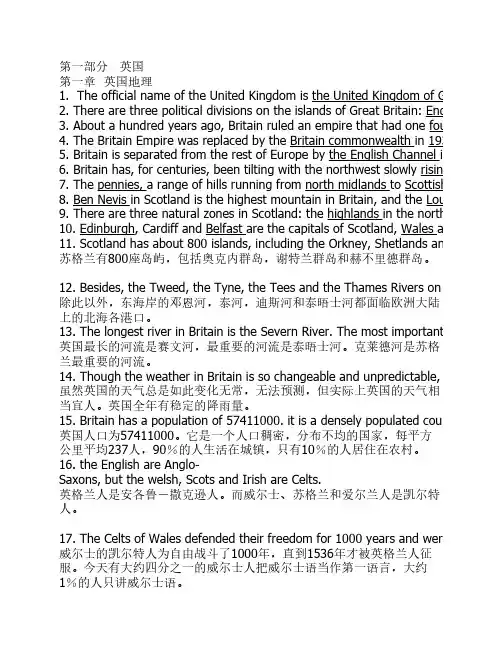
第一部分英国第一章英国地理1. The official name of the United Kingdom is the United Kingdom of Great Britain2. There are three political divisions on the islands of Great Britain: England, Scotl3. About a hundred years ago, Britain ruled an empire that had one fourth4. The Britain Empire was replaced by the Britain commonwealth in 19315. Britain is separated from the rest of Europe by the English Channel in the south6. Britain has, for centuries, been tilting with the northwest slowly rising,7. The pennies, a range of hills running from north midlands to Scottish8. Ben Nevis in Scotland is the highest mountain in Britain, and the Lough Neagh9. There are three natural zones in Scotland: the highlands in the north, the centr10. Edinburgh, Cardiff and Belfast are the capitals of Scotland, Wales and Norther11. Scotland has about 800 islands, including the Orkney, Shetlands and Hebrides 苏格兰有800座岛屿,包括奥克内群岛,谢特兰群岛和赫不里德群岛。
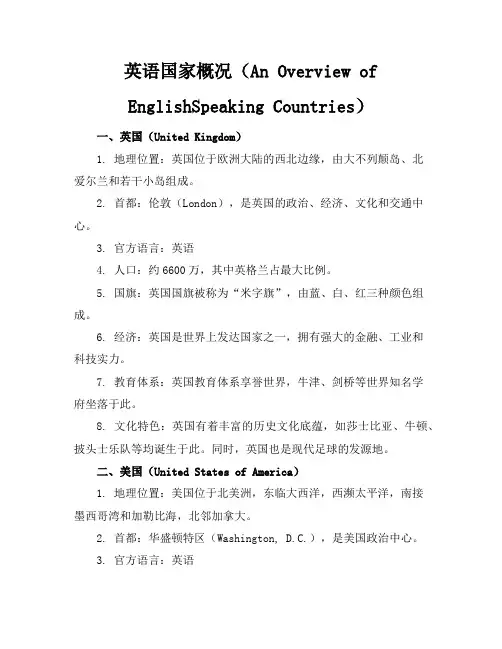
英语国家概况(An Overview ofEnglishSpeaking Countries)一、英国(United Kingdom)1. 地理位置:英国位于欧洲大陆的西北边缘,由大不列颠岛、北爱尔兰和若干小岛组成。
2. 首都:伦敦(London),是英国的政治、经济、文化和交通中心。
3. 官方语言:英语4. 人口:约6600万,其中英格兰占最大比例。
5. 国旗:英国国旗被称为“米字旗”,由蓝、白、红三种颜色组成。
6. 经济:英国是世界上发达国家之一,拥有强大的金融、工业和科技实力。
7. 教育体系:英国教育体系享誉世界,牛津、剑桥等世界知名学府坐落于此。
8. 文化特色:英国有着丰富的历史文化底蕴,如莎士比亚、牛顿、披头士乐队等均诞生于此。
同时,英国也是现代足球的发源地。
二、美国(United States of America)1. 地理位置:美国位于北美洲,东临大西洋,西濒太平洋,南接墨西哥湾和加勒比海,北邻加拿大。
2. 首都:华盛顿特区(Washington, D.C.),是美国政治中心。
3. 官方语言:英语4. 人口:约3.3亿,是世界上第三人口大国。
5. 国旗:美国国旗被称为“星条旗”,由红、白、蓝三种颜色组成。
6. 经济:美国是全球最大的经济体,拥有强大的科技创新能力和金融市场。
7. 教育体系:美国教育资源丰富,世界顶尖大学如哈佛、斯坦福等均位于此。
8. 文化特色:美国文化多元化,涵盖了欧洲、亚洲、非洲等多种文化元素。
好莱坞电影、NBA篮球、美式足球等在全球具有广泛影响力。
三、加拿大(Canada)1. 地理位置:加拿大位于北美洲北部,东临大西洋,西濒太平洋,北接北冰洋,南邻美国。
2. 首都:渥太华(Ottawa),是加拿大的政治中心。
3. 官方语言:英语和法语4. 人口:约3800万,是世界上面积第二大国家。
5. 国旗:加拿大国旗被称为“枫叶旗”,由红、白两色组成。
6. 经济:加拿大经济发达,资源丰富,特别是石油、天然气和矿产资源。
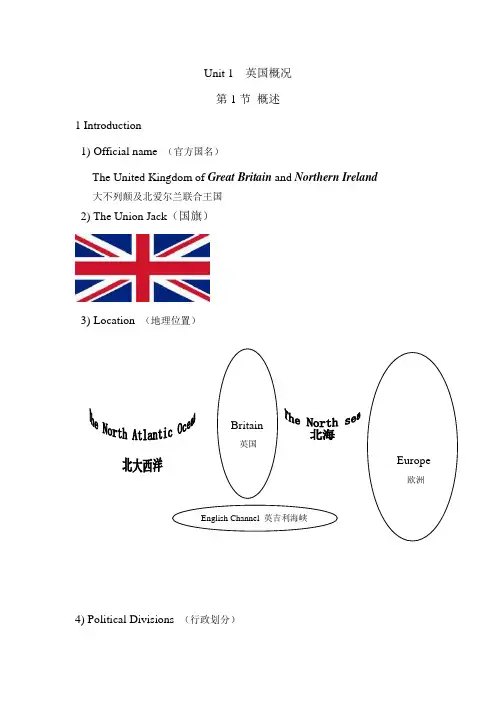
Unit 1 英国概况 第1节 概述1 Introduction1) Official name (官方国名)The United Kingdom of Great Britain and Northern Ireland 大不列颠及北爱尔兰联合王国 2) The Union Jack (国旗)3) Location (地理位置)4) Political Divisions (行政划分)England Scotland Wales Northern Ireland英格兰 苏格兰 威尔士 北爱尔兰London Edinburgh Cardiff Belfast伦敦 爱丁堡 加的夫 贝尔法斯特Population: England > Scotland > Wales > Northern Ireland Area : England > Scotland > Wales > Northern Ireland★ 1) 英格兰占地面积有13万平方公里,占整个岛屿的近乎60%2) 大部分苏格兰人使用的语言是英语,Gaelic (苏格兰盖尔语)是高地苏格兰人的传统语言3) 爱尔兰共和国的官方语言为爱尔兰语,英语为第二语言2 Ethnic Group (少数民族)English Scottish Welsh Irish Northern Irish 英格兰人 苏格兰人 威尔士人 爱尔兰人 北爱尔兰人3 Major Cities 1) London (Capital)位于英格兰东南部,英国第一大城市和港口,欧洲最大的经济中心 传媒中心:BBC Reuters ITV Channel 4Channel 5报刊:The Times Financial Times Daily Telegraph The Guardian The Observer建筑:British Museum (大英博物馆)<18世纪,世界最大的博物馆> St Paul’s Cathedral (圣保罗大教堂)Buckingham Palace (白金汉宫)Westminister Abbey (威斯敏斯特教堂)Palace of Westminister (威斯敏斯特宫)<英国议会所在地>bell tower of Big Ben (大本钟)2) Birmingham (伯明翰)University of Birmingham (伯明翰大学)3) Glasgow (格拉斯哥)苏格兰最大的城市和港口,主要文化中心,多所高校聚集在此University of Glasgow (格拉斯哥大学)4) Liverpool (利物浦)位于英格兰西北部Mercy海口,临爱尔兰海,第二深水海港,Beatles故乡5) Manchester (曼彻斯特)英格兰西北部城市,纺织业中心4 National Economics1) Primary Industries①Agriculture (农业)Chief area: in the east in the southeastBest land: in the southeast of EnglandImportant Crop: wheat barley(小麦和大麦)②Fishing (渔业)③Mining (采矿)2) Secondary Industries①Manufacturing (制造业)Highly proportion of employee: East Midlands 19%West Midlands 18% Lowest proportion of employee: London 6%②Shipbuilding (造船)<19世纪中期成为霸主>Main center: on the River Tyne (泰恩河)near Newcastle (纽卡斯尔)On the Clyne (克莱德河)near Glasgow③Engineering (机械)8 global car manufacturer: BMW Tata General MotorsHonda (本田)Nissan (尼桑)Toyota (丰田)V olkswagen (大众)④Others: Electronics is the forth largest in the world3) Tertiary Industries <70% 的人受雇于服务业>Major business service: financial sector and advertising★London : one of the top three financial centers in the world世界三大金融中心之一The greatest concentration of foreign banks in the world国外银行的聚集地The world’s largest foreign exchange market世界最大的外汇市场London Stock Exchange 伦敦证券交易所。
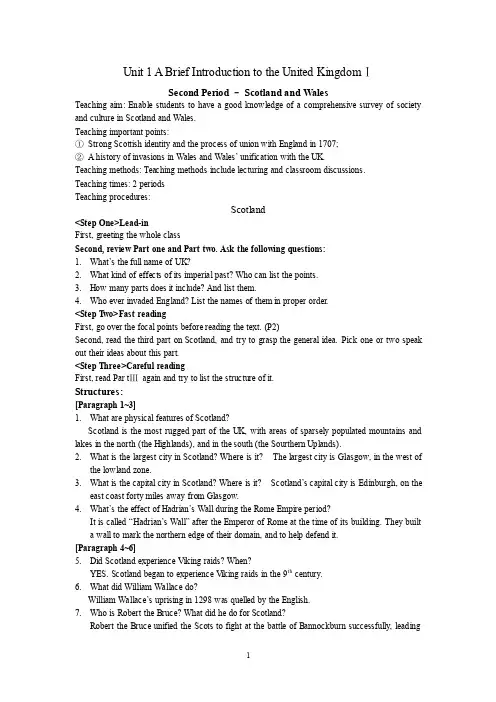
Unit 1 A Brief Introduction to the United KingdomⅠSecond Period – Scotland and W alesTeaching aim: Enable students to have a good knowledge of a comprehensive survey of society and culture in Scotland and Wales.Teaching important points:①Strong Scottish identity and the process of union with England in 1707;②A history of invasions in Wales and Wales’ unification with the UK.Teaching methods: Teaching methods include lecturing and classroom discussions.Teaching times: 2 periodsTeaching procedures:Scotland<Step One>Lead-inFirst, greeting the whole classSecond, review Part one and Part two. Ask the following questions:1.What’s the full name of UK?2.What kind of effects of its imperial past? Who can list the points.3.How many parts does it include? And list them.4.Who ever invaded England? List the names of them in proper order.<Step T wo>Fast readingFirst, go over the focal points before reading the text. (P2)Second, read the third part on Scotland, and try to grasp the general idea. Pick one or two speak out their ideas about this part.<Step Three>Careful readingFirst, read Par tⅢagain and try to list the structure of it.Structures:[Paragraph 1~3]1.What are physical features of Scotland?Scotland is the most rugged part of the UK, with areas of sparsely populated mountains and lakes in the north (the Highlands), and in the south (the Sourthern Uplands).2.What is the largest city in Scotland? Where is it? The largest city is Glasgow, in the west ofthe lowland zone.3.What is the capital city in Scotland? Where is it? Scotland’s capital city is Edinburgh, on theeast coast forty miles away from Glasgow.4.What’s the effect of Hadrian’s Wall during the Rome Empire period?It is called “Hadrian’s Wall” after the Emperor of Rome at the time of its building. They builta wall to mark the northern edge of their domain, and to help defend it.[Paragraph 4~6]5.Did Scotland experience Viking raids? When?YES. Scotland began to experience V iking raids in the 9th century.6.What did William Wallace do?Wi lliam Wallace’s uprising in 1298 was quelled by the English.7.Who is Robert the Bruce? What did he do for Scotland?Robert the Bruce unified the Scots to fight at the battle of Bannockburn successfully, leadingto 300 years of full independence.8.Who united the two thrones?James the Sixth of Scotland (James the First of England)9.When did Scotland join the Union? In 1707 by agreement of the English[Paragraph 7] the brief introduction to the politics of ScotlandKey words: the Scotland Act 1998(苏格兰法案), the Labour Party, the Scottish National Party, and the Conservative Party.1.The Scotland Act 1998 provided for the establishmeng of the Scottish Parliament andExecutive.2.The Labour Party, which had traditionally done well in elections in Scotland, became thelargest single party.3.The Scottish National Party which wants an independent Scotland is the second largest partyand the Conservative Party the third largest in the Parliament.[Paragraph 8] strong Scottish identityKey words: Walter Scott, Robert Burns and Robert Louis Stevenson1.The inventor of the telephone was a Scot, and the first man to transmit a television picture wasanother.2.Its writers have given the world such well-known work as Walter Scott’s romances ofhighland Scotland, and “Auld Lang Syne” (by Robert Burns, who wrote in the Scots dialect).3.The work is the famous novel Dr Jekyll and Mr Hyde, by Robert Louis Stevenson. ·Thirdly, explain something important in details, such as Hadrian’s Wall, Robert the Bruce, Battle of Bannockburn, Queen Elizabeth the First, the Scotland Act 1998 and so on.<Step Four>Presentation1. Physical features of Scotland2. Cultural division between highland and lowland – The division between highland and lowland Scotland remains a cultural divide today. There are even areas in the highlands where people speak old Celtic language, called “Gaelic”.3. The Battle of Bannockburn –It was a significant Scottish victory in the Wars of Scottish Independence. It was the decisive battle in the First War of Scottish Independence.4. Independence of Scotland for 300 years – It is a political ambition of political parties, advocacy groups and individuals for Scotland to secede from the United Kingdom and regain sovereignty.5. Union with England in 1707 – In 1603, Queen Elizabeth the First of England died childless, and the next in line to the throne was James the Sixth of Scotland, so he also became James the First of England, uniting the two thrones. In 1707 by agreement of the English and Scottish parliaments, Scotland joined the Union.6. Strong Scottish identity – Scotland has a great tradition of innovation in the arts, philosophy and science.ADD CONTENTS:苏格兰概况苏格兰(盖尔语:Alba)是大不列颠与北爱尔兰联合王国下属的王国之一,位于大不列颠岛北部,英格兰之北,以格子花纹,风笛音乐,畜牧业与威士忌工业而闻名。
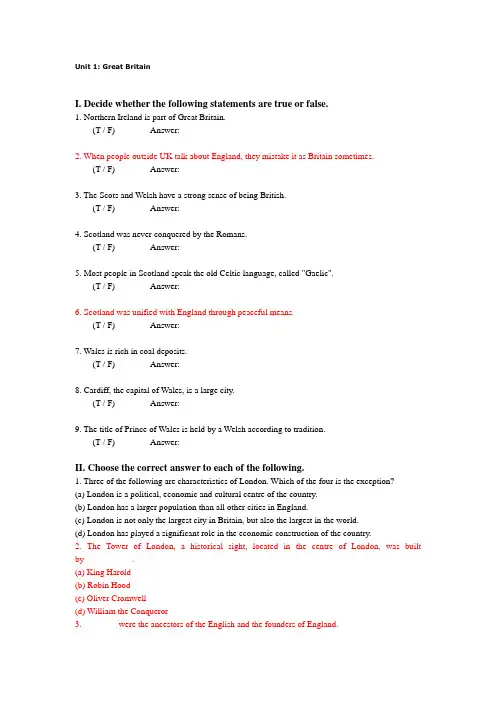
Unit 1: Great BritainI. Decide whether the following statements are true or false.1. Northern Ireland is part of Great Britain.(T / F)Answer:2. When people outside UK talk about England, they mistake it as Britain sometimes.(T / F)Answer:3. The Scots and Welsh have a strong sense of being British.(T / F)Answer:4. Scotland was never conquered by the Romans.(T / F)Answer:5. Most people in Scotland speak the old Celtic language, called "Gaelic".(T / F)Answer:6. Scotland was unified with England through peaceful means.(T / F)Answer:7. Wales is rich in coal deposits.(T / F)Answer:8. Cardiff, the capital of Wales, is a large city.(T / F)Answer:9. The title of Prince of Wales is held by a Welsh according to tradition.(T / F)Answer:II. Choose the correct answer to each of the following.1. Three of the following are characteristics of London. Which of the four is the exception?(a) London is a political, economic and cultural centre of the country.(b) London has a larger population than all other cities in England.(c) London is not only the largest city in Britain, but also the largest in the world.(d) London has played a significant role in the economic construction of the country.2. The Tower of London, a historical sight, located in the centre of London, was built by___________.(a) King Harold(b) Robin Hood(c) Oliver Cromwell(d) William the Conqueror3.________ were the ancestors of the English and the founders of England.(a) The Anglo-Saxons(b) The Normans(c) The Vikings(d) The Romans4. __________ is the largest city in Scotland.(a) Cardiff(b) Edinburgh(c) Glasgow(d) Manchester5. Why did the Scottish Kings decide to form an independent singular Scottish state in the ninth century?(a) They needed a unified independent nation to fight against Viking raids.(b) They felt it necessary to develop their own industry.(c) They were threatened by the Anglo-Saxons' invasion.(d) They had to do it in order to resist the English.6. Where do the majority of people in Scotland live?(a) In the Highlands.(b) In the Lowlands.(c) In the Uplands.(d) In the west of Scotland.7. Which of the following statements is not true?(a) Wales was invaded by the Romans.(b) Wales was occupied by the Anglo-Saxons.(c) Wales was conquered by the Normans.(d) Wales was threatened by the English.8. Which of the following parties in Scotland still wants an independent Scotland?(a) The Labour Party.(b) The Liberal Party.(c) The Scottish Nationalist Party.(d) The Conservative Party.9. Scotland joined the Union by agreement of the English and Scottish parliaments ________.(a) In 1715(b) In 1688(c) In 1745(d) In 170710. Llywelgn ap Gruffudd is more than a simple historical figure for the Welsh. He is almost considered the legendary hero of Welsh nationalism because___________.(a) he became the first Prince of Wales in 1267(b) he brought the English under his control(c) he led a historic uprising against the English(d) he unified Wales as an independent nationIII. Fill in the blanks:1. Britain consists of nations, including England, and .2. Britain is a country with a history of invasions. In 43 AD Britain was invaded by , in the late 8th century they experienced raids from Scandinavia and in the 11th century they suffered invasions from .3. The Anglo-Saxons began to settle in Britain in century.4. The capital of Britain is , which has great influence on the UK in all fields including , and .5. Charles the First, king of Britain, was executed, because he attempted to in the English Revolution.6. Name two Scottish cities with ancient and internationally respected universities: and .7. The battle of Bannockburn led by Robert the Bruce succeeded in winning the full independence of .8. Both the Scottish and Welsh people elect their members of parliaments to the London Parliament and each holds and seats respectively.9. The capital of Scotland is , which is well-known for its natural .10. Although Wales is the smallest of the three nations on the mainland, it's good at getting from abroad, particularly Japan and .IV. Explain the following in English:1. The British Isles2. Robin Hood3. The Anglo-Saxons4. The Vikings5. King Arthur6. King Harold。
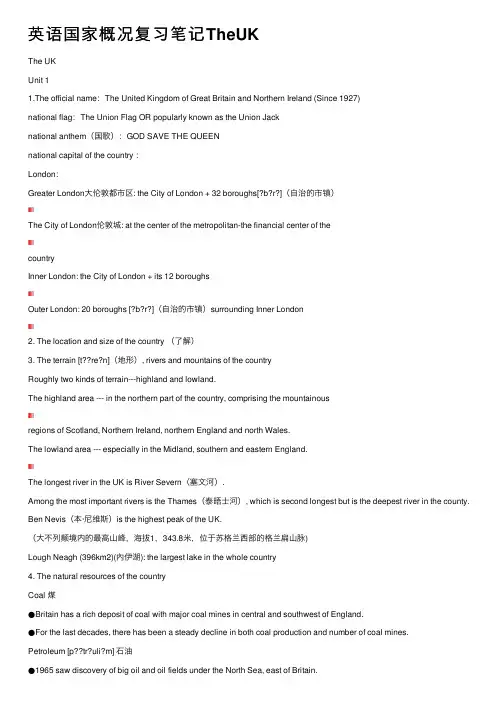
英语国家概况复习笔记TheUKThe UKUnit 11.The official name:The United Kingdom of Great Britain and Northern Ireland (Since 1927)national flag:The Union Flag OR popularly known as the Union Jacknational anthem(国歌):GOD SAVE THE QUEENnational capital of the country :London:Greater London⼤伦敦都市区: the City of London + 32 boroughs[?b?r?](⾃治的市镇)The City of London伦敦城: at the center of the metropolitan-the financial center of thecountryInner London: the City of London + its 12 boroughsOuter London: 20 boroughs [?b?r?](⾃治的市镇)surrounding Inner London2. The location and size of the country (了解)3. The terrain [t??re?n](地形), rivers and mountains of the countryRoughly two kinds of terrain---highland and lowland.The highland area --- in the northern part of the country, comprising the mountainousregions of Scotland, Northern Ireland, northern England and north Wales.The lowland area --- especially in the Midland, southern and eastern England.The longest river in the UK is River Severn(塞⽂河).Among the most important rivers is the Thames(泰晤⼠河), which is second longest but is the deepest river in the county. Ben Nevis(本·尼维斯)is the highest peak of the UK.(⼤不列颠境内的最⾼⼭峰,海拔1,343.8⽶,位于苏格兰西部的格兰扁⼭脉)Lough Neagh (396km2)(內伊湖): the largest lake in the whole country4. The natural resources of the countryCoal 煤●Britain has a rich deposit of coal with major coal mines in central and southwest of England.●For the last decades, there has been a steady decline in both coal production and number of coal mines.Petroleum [p??tr?uli?m] ⽯油●1965 saw discovery of big oil and oil fields under the North Sea, east of Britain.5. The climate of the countryTemperate maritime climate(温带海洋性⽓候)What are the characteristics of the climate in Great Britain?FoggyRainyUncertain and changeable6. Major citiesLondon ;Edinburgh [?edn?b?:r?] 爱丁堡;Cardiff [?kɑ:d?f] 加地夫(威尔⼠的主要海港);Belfast [?bel?f?st] 贝尔法斯特(北爱尔兰⾸府);Birmingham ['b?:mh?m] 伯明翰市(英国中部城市,第⼆⼤城市)Manchester: the Guardian(卫报)Glasgow:[?ɡlɑ:sɡ?u] 格拉斯哥(苏格兰最⼤城市,第三⼤城市)7. Population Density and Population DistributionPopulation density: 248 persons per square kilometer.The Population of the UK is the 3rd largest in Europe.Population distribution: high urbanization (7 conurbations)7 conurbations:Greater London⼤伦敦区, W. Midlands西密德兰都市郡, South Yorkshire 南约克都市郡, W. Yorkshire西约克郡都市郡, Greater Manchester⼤曼切斯特都市郡, Merseyside默西赛德都市郡(England), Tyne& Wear泰恩及威尔都市郡(Scotland) (了解)8. Nations and the Languages Spoken1) Nations: English, Scottish, Welsh and IrishEnglish (80%): descendants [d?'send?nts] 后裔of Anglo-SaxonsWelsh, Irish & Scottish::descendants of Celts2)Languages:A) English (official language):B) Gaelic [?g?l?k] 盖尔语: Scotland & Northern IrelandC) Welsh [wel?] 威尔⼠语: Wales [we?lz]3) T he history and development of the English language(p.7)Old English (450AD-1100 AD) influenced by Old Norse (古斯堪的纳维亚语) spoken by Vikings (北欧海盗) and was closely related to the German and Dutch (荷兰) languages. The introduction of Christianity added the first wave of Latin and Greek words to the language and ended with the Norman Conquest.Middle English (1100AD-1500AD) French replaced English as the official language in England. Numerous French words came into the English vocabulary and ended with the Black Death (⿊死病).Modern English (1500AD- present) Assimilating(吸收) words from Latin and Greek words throughout the Renaissance (⽂艺复兴) such as William Shakespeare and the King James Bible.Standard English= the Queen’s Englis h= BBC EnglishExplanation of Standard EnglishStandard English is based on the speech of the upper class of the southeastern England.It is preferred by the educated andit is widely used in media and taught at schools. Is has developed and has been promoted as a model for the correct British English. It is also the norm(标准)carried overseas. Today, Standard English is codified to the extent that the grammar and vocabulary are much the same everywhere in the world where English is taught and used.9. Religion1. Britain is a multi-faith society in which everyone has the right to religious freedom.2. Christianity is the dominant religion of the country. Most of citizens are eitherProtestant ['pr?t?st?nt]新教徒or Catholic.3. English nation: The church of England(英格兰圣公会)is the established church of theEnglish nation.4. The major non-Christian communities in Britain are the Jews, the Moslems and theBuddhists.10. Character and manners of British peopleConservatismTalking about the WeatherPunctuality11. Traditions and custom●Trooping the Color英国皇家军队阅兵仪式around the Bucking Place in London(P.62)to celebrate the Queen’s Birthday Parade. (The Changing Guard ceremony)●Religious FestivalsChristmas ( Three Christmas Traditions )①Christmas pantomime [?p?nt?ma?m] (童话剧)②Queen's Christmas message③Boxing Day(节礼⽇)Easter纪念耶稣复活Halloween12. MediaNewspaperTraditionally British newspapers have been divided into "quality", serious-minded newspapers (usually referred to as "broadsheets宽幅印刷品" because of their large size) and the more populist ['p?pj?l?st] 平民化, "tabloid" varieties.Quality Press: The Times(泰晤⼠报), The Guardian(卫报), The Daily Telegraph(每⽇电讯报)Tabloid [?t?bl??d] 通俗⼩报: The Sun on SundayTelevision and BroadcastBBC(the British Broadcasting Corporation), ITV(Independent Television) 英国独⽴电视台, BSkyB(the British Sky Broadcasting Group PLC)英国天空⼴播集团TV programs done well by the BBC (P.60)Unit 4. British Economy1. The Relative Decline of British Economy (Why?)1) The country suffered a great loss in the two World Wars.2) The era[r]时代of the British Empire was over.3) Britain was still forced to maintain a substantial and expensive military presence.4) Britain failed to invest in industry after WWII.However, the decline is not an absolute one. The UK is not poorer than before. In fact, it iswealthier and more productive than before. The only thing is that other countries develop faster than the UK. So, the UK has experienced a relative decline.2. Recent History of British Economy1970 - high Inflation rate, strikes1979 - Reformation Program(改⾰⽅案)by Thatcher government→去国有化privatization [?pra?v?ta?'ze??n]What was the content of the programThatcherism [?θ?t??(r)z?m] 撒切尔主义:Throughout the 1980s an extensive program of privatization was carried out.---Denationalization [?di:?n??n?la?'ze??n] ⾮国有化①Government expenditure [?k?spend?t??(r)] 花费was reduced;②Taxation reformed;③Foreign exchange controls lifted外汇管制解除④Rules governing banks loosened;⑤Worker strikes restricted.What was the long-term results①Inflation(通货膨胀) has been controlled②Unemployment rate falling③Encouraged by low interest rates, investment has increased. It is second only to the US as a destination for international direct investment. It is also itself a major source of international investment --- it is the second biggest international investor in the world.Policies of Blair Government & Results (P.45)Policies: ①Blair made the Bank of England independent.②In social policy, the Blair government changed the old Labor Party’s practice of usingtax system, public expenditure[?k?spend?t??(r)] 花费and price controls to reduce inequality and put an emphasis on the minimum wage and supplementing low incomes. It also emphasized individual responsibility.Results:①limit government spending②keep inflation under control③reduce unemploymentBy the end of the 20th century, British economic growth surpassed that of other major European countries.3. The Current British Economy1) Primary IndustriesAgricultureA. Features: small population, high mechanization[?mek?na?'ze??n]机械化and highefficiency; but can not satisfy its domestic needsB. Chief agricultural products:wheat(⼩麦),barley [?bɑ:li]⼤麦,sugar beet(甜菜) and potatoesEnergy production (5% of national wealth).Main energy resources: coal (Rio Tinto Group⼒拓集团),oil (Shell 壳牌, British Petroleum and British Gas)2) Secondary Industries:P .473) Tertiary Industries: 65% of national wealth1. (P .50)Foreign Trade ---- Lifeline. Britain is both an importer and exporter in the world.2. FinanceThe position of London in the world economyCentral Bank----Bank of EnglandThe Big Four: Lloyds 劳埃德, Barclays 巴克莱银⾏, Midland ⽶德兰,the National Westminster Bank Group 国民西敏寺银⾏3. Currency :Pound Sterling [paund ?st ?:li ?] 英镑Unit 3 Political System1. Political System : Constitutional Monarchy [ ?k ?nst ??tu:??n ?l ?m ?n ?ki ] 君主⽴宪制What does it mean by Constitutional Monarchy?The King or Queen reigns [re n]君主统治and is the head of the country, but dose notrule the country. The country is governed, in the name the Sovereign [ ?s ?vr ?n ] 君主, but by His or Her Majesty ’s [ ?m?d ?? sti ]陛下government---- a body of ministers who are responsible to Parliament [ ?p ɑ:l?m ?nt ]议会.2. Parliament议会(最⾼⽴法机关)、⽴法政府、⾏政部门司法机关 [ d ?u?d ri ]上议院下议院君主Parliament:The UK is a unitary [ ju:ntri ]中央集权country.The British Parliament is often referred to assupreme legislative authority(最⾼⽴法机关)of the UK.The Main functions are making laws and supervising(监督)government and finance.The life of Parliament is fixed at five years.Sovereign: Theoretically[ ?θ??'ret?kl? ]理论上, the Queen has all the power. In reality, she does everything on the advice of the Prime Minister.The significance of the Queen? P.32It represents the continuity and adaptability of the whole political system and is a symbol of British unity, an indissoluble [ ?? nd??s?lj?bl ] (牢不可破的) bond among people who retain many regional and cultural difference.( 它代表了整个政治体系的连续性和适应性,是英国团结的象征,⼈们保留了许多地区和⽂化差异的不解之缘。
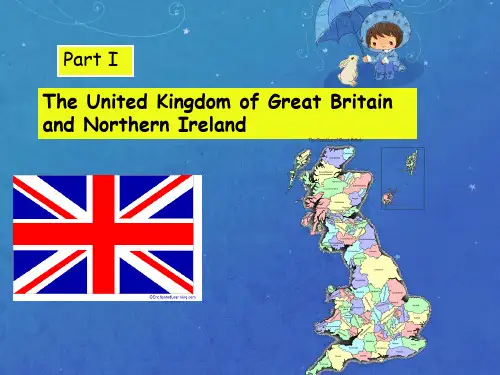
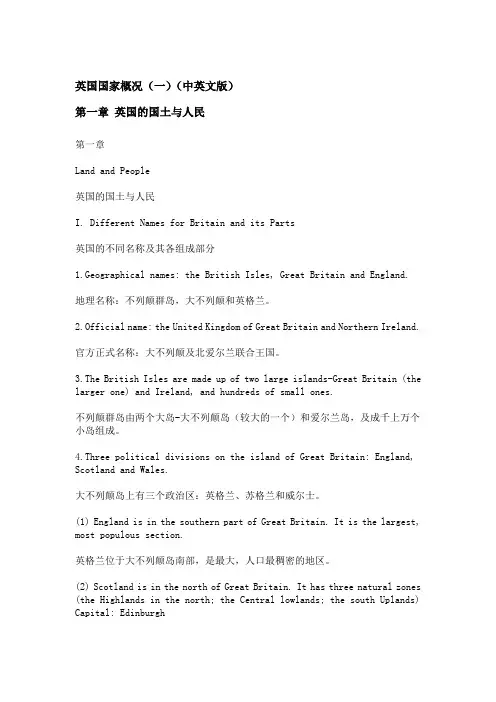
英国国家概况(一)(中英文版)第一章英国的国土与人民第一章Land and People英国的国土与人民I. Different Names for Britain and its Parts英国的不同名称及其各组成部分1.Geographical names: the British Isles, Great Britain and England.地理名称:不列颠群岛,大不列颠和英格兰。
2.Official name: the United Kingdom of Great Britain and Northern Ireland.官方正式名称:大不列颠及北爱尔兰联合王国。
3.The British Isles are made up of two large islands-Great Britain (the larger one) and Ireland, and hundreds of small ones.不列颠群岛由两个大岛-大不列颠岛(较大的一个)和爱尔兰岛,及成千上万个小岛组成。
4.Three political divisions on the island of Great Britain: England, Scotland and Wales.大不列颠岛上有三个政治区:英格兰、苏格兰和威尔士。
(1) England is in the southern part of Great Britain. It is the largest, most populous section.英格兰位于大不列颠岛南部,是最大,人口最稠密的地区。
(2) Scotland is in the north of Great Britain. It has three natural zones (the Highlands in the north; the Central lowlands; the south Uplands) Capital: Edinburgh苏格兰位于大不列颠的北部。
精心整理英国国家概况(一)(中英文版)第一章英国的国土与人民第一章Land and People4.Three political divisions on the island of Great Britain: England, Scotland and Wales.大不列颠岛上有三个政治区:英格兰、苏格兰和威尔士。
(1) England is in the southern part of Great Britain. It is the largest,most populous section.英格兰位于大不列颠岛南部,是最大,人口最稠密的地区。
(2) Scotland is in the north of Great Britain. It has three natural zones (the Highlands in the north; the Central lowlands; the south Uplands) Capital: Edinburgh1.Geographical position of Britain:英国的地理位置:Britain is an island country surrounded by the sea. It lies in the North Atlantic Ocean off the north coast of Europe. It is separated from the rest of Europe by the English Channel in the south and the North Sea inthe east.英国是一个岛国。
它位于大西洋北部,与欧洲大陆的北海岸隔海相望。
南面的英吉利海峡和东面的北海将它与欧洲其它部分隔开。
2.The north and west of Britain are mainly highlands; and the east and southeast are mostly lowlands.讷湖(内伊湖)是英国最大的湖,位于北爱尔兰。
Unit 1&2 A Brief Introduction To The United Kingdom【国名】大不列颠及北爱尔兰联合王国(The United Kingdom of Great Britain and Northern Ireland)【地理】位于欧洲西部的岛国。
由大不列颠岛(包括英格兰、苏格兰、威尔士)、爱尔兰岛东北部和一些小岛组成。
隔北海、多佛尔海峡、英吉利海峡与欧洲大陆相望。
【行政区划】分英格兰、威尔士、苏格兰和北爱尔兰四部分。
【简史】公元前地中海伊比利亚人,比克人,凯尔特人,先后来到不列颠。
公元1-5世纪大不列颠岛东南部为罗马帝国统治。
罗马人撤走后,欧洲北部的盎格鲁人、萨克逊人、朱特人相继入侵并定居。
7世纪开始形成封建制度,许多小国并成七个王国,争雄达200年之久,史称“盎格鲁—撒克逊时代”。
829年威塞克斯国王爱格伯特统一了英格兰,史称“盎格鲁-撒克逊时代”。
8世纪末遭丹麦人侵袭,1016年至1042年为丹麦海盗帝国的一部分。
其后经英王短期统治,1066年诺曼底公爵渡海征服英格兰,建立诺曼底王朝。
1215年约翰王被迫签署大宪章,王权遭抑制。
1338年至1453年英法进行“百年战争”,英国先胜后败。
1536年英格兰与威尔士合并。
1588年击败西班牙“无敌舰队”,树立海上霸权。
1640年英国在全球第一个爆发资产阶级革命,成为资产阶级革命的先驱。
1649年5月19日宣布成立共和国。
1660年王朝复辟,1668年发生“光荣革命”,确定了君主立宪制。
1707年英格兰与苏格兰合并,1801年又与爱尔兰合并。
18世纪后半叶至19世纪上半叶,成为世界上第一个完成工业革命的国家。
19世纪是大英帝国的全盛时期,1914年占有的殖民地比本土大111倍,是第一殖民大国,自称“日不落帝国”。
第一次世界大战后开始衰败。
英国于1920年设立北爱兰郡,并于1921年至1922年允许爱尔兰南部脱离其统治,南部26郡成立“自由邦”,北部6郡仍归英国。
英语国家概况第⼀章知识点Chapter 1 Land and People第01讲Geographical Features & Climate Part I the United Kingdom of Great Britain and Northern Ireland Chapter 1 Land and PeopleNames【译⽂】第⼀编英国第⼀章国⼟与⼈民名称different names for 英国The United Kingdom of Great Britain and Northern Irelandthe United Kingdomthe UKGreat Britain (GB)BritainEnglandthe total population: 63 million.the third-largest in the European Union (behind Germany and France) and the 22nd-largest in the world.【译⽂】“英国”不同的名称:⼤不列颠及北爱尔兰联合王国联合王国⼤不列颠(GB)不列颠英格兰总⼈⼝:6300 0000英国是欧洲第三⼈⼝⼤国(排在德国和法国后⾯),是世界第⼆⼗⼆⼈⼝⼤国。
The UK is a developed country.the sixth-largest national economy in the world (and third-largest in Europe)measured by nominal GDP and eighth-largest in the world (and second-largest in Europe) measured by purchasing power parity (PPP).It was the world’s first industrialized country and the world’s foremost power during the 19th and early 20th centuries.【译⽂】英国是⼀个发达国家。
Unit1 A Brief Introduction to the United Kingdom 1.The flag of Britain : Union Jack(英国国旗中没有显示出Welsh旗)2. The basic information of each country:Count ry Capital AreaMemoEngland London最大1.最不会把自己的“英格兰文化区别于其他文化”2.一个高度城市化3.The time joining the British parliament: However, in 1707 by agreement of the English and Scottish parliaments, Scotland joined the Union.4.Difference between the British Isles ,UK, Great Britain , and England:British Isles:the island of Great Britainthe island of Irelandsurrounding isles●UK=Great Britain + Northern Ireland●Great Britain =England +Scotland + Wales5.The four major invasions in the history of Great Britain :At first, England was occupied by Celtic people.Then in 43AD Britain was invaded by the Roman Empire.Result: England and Wales became a part of the Roman Empire for nearly 400 years.the Angle-Saxon invaded.Result: The land they lived became" Angle-land", later changed into England, the language they spoken became English.PS:One of the best-known English legends derives from this time. In 5 century AD, King Author(亚瑟王) united the British, and with his magical sword, Excalibur(被称为“王者之剑”的圣剑),drove the Saxons back.关于亚瑟王的一些名词:Excalibur:被称为“王者之剑”的圣剑;亚瑟王之魔剑Castle at Tintagel(廷塔杰尔) in Cornwall: Tintagel传说为亚瑟王的诞生地,这是一个与亚瑟王传奇有关的地方。
英美文化与国家概况British and American Studies ( British Part )Unit One大学英语第一教研室余非编2013年2月Unit 1 The Country and the People Contents:1.Geographic Features2.People and Religion3.Official and Local Languages------------------------------------------------------------------------------------------------------ 1. Geographic Features1.1Component (组成部分)✧To the west and off the European Continent, several thousand of islands exist on theContinental Shelf. They are generally called the British Isles(不列颠群岛).✧Of all these isles, the largest one is called Great Britain(大不列颠;英国). For the sake ofconvenience, Great Britain is often shorten to Britain.✧The island of Great Britain runs nearly 1,000 kilometers from south to north . It extends , atthe widest part, about 500 kilometers from west to east.✧Still to the west of Great Britain is Ireland , the second largest island. It is politically dividedinto two parts, the Republic of Ireland and Northern Ireland.✧The United Kingdom of Great Britain and Northern Ireland (大不列颠及北爱尔兰联合王国)is made up of Great Britain, Northern Ireland and a number of smaller islands around them.The total area of U.K. is over 245,000 square kilometers. Its total population is about60.94million (2008)Traditionally, Great Britain is divided into three countries or political regions:✧England in the south✧Scotland in the north✧Wales in the southwest.England :✧The largest area of all the three✧Its area : almost 60% of the whole island✧Its population : over 50 million .✧The importance of Engla nd is so great in Britain that some foreigners just say “England”when they mean Britain, and they say the “English people” when they mean the British people.Scotland :✧The second largest both in area and population✧Its area : about 78,760 square kilometers✧Its population : more than 5 million.Wales✧The smallest of the three both in area and population✧Its area : about 20,700 square kilometers✧Its population : about 2.7 million.Northern Ireland✧Its area : about 14,000 square kilometers✧Its population : about 1.5 million.Supplement 1Ireland✧Ireland was an independent kingdom before the Anglo-Norman(盎格鲁-诺曼语的)invaders came. Henry VIII(亨利八世)was the first English king to conquer Ireland and force English law on the Irish people. Soon after the conquest, large numbers of Scottish immigrants came in and established a colony in Ulster (阿尔斯特), another name for Northern Ireland.✧The Irish people were mostly Roman Catholics (罗马天主教)and they were opposed to theEnglish occupation. The English Government put down the rebellion made by the Irish people and passed the Penal Law (刑法) in 1690, which deprived the Irish Catholics of all their legal rights.✧Irish people never stopped fighting for independence. Their successful struggle finally led tothe establishment of the Republic of Ireland in 1927 within British Commonwealth(英联邦.In 1948 Ireland withdraw from Commonwealth and declared itself a republic.✧However, since most of the immigrants from Britain were Protestants (新教徒) , theyrefused to separate themselves form their home country. They held the northeast of the island , and up to now they continue to keep it within the United Kingdom. It is today’ s Northern Ireland.Supplement 2Irish Republican Army ( IRA)✧Nowadays, in Northern Ireland there are one-third of people are still Roman Catholics ,whodemand independence from Britain that is dominated by Protestantism (新教徒主义、新教徒).✧Therefore, some radical Roman Catholics organized a military group fighting for theindependence of Northern Ireland. It often resorts to terrorist campaigns (战役;活动)of bombing, murdering and arson.1.2 Physical Features(自然特色)✧Leaving Ireland on one side, The island of Great Britain can be divided into two partsaccording to its geographic features:1) The Highland Zone in the north and west and2) The Lowland Zone in the south and southeast.✧Britain is an island country, with its coastline running about 8,000 kilometers.✧The coastline is highly irregular with many bays and inlets that provide lots of harbors andshelters for ship and boats.✧As an island country, Great Britain does not share a land border with any other countriesexcept the Republic of Ireland.✧To the north of Great Britain the seaway is open and leads to the Arctic Ocean(北冰洋).✧Across the North Sea Britain faces such countries as Holland, Germany , Denmark andNorway.✧To the southeast and across the English Channel is France , which is linked with Britain by atunnel called the Channel Tunnel (海峡隧道),open to traffic in 1994, was built by Britishand French private investors. The main tunnel is 50-km long at an average depth of 40 meters below the seabed.✧The tunnel has great symbolic importance as an unbroken link between Britain and theEuropean Continent.The Highlands of Scotland:✧Scotland is a mountainous country , with its highlands taking up over half of the country. BenNevis, the highest mountain in Britain, with an elevation of 1,300 meters in North Scotland. The Central Lowlands of Scotland:✧ A great valley , which forms the Central Lowlands of Scotland , is lying to the south of theHighlands of Scotland, the valley is also called the Middle Valley. It is the most important economic region in Scotland and accommodates three-quarters of Scotland’s total population.✧The Southern Uplands: The land on the southern side of the Central Lowlands of Scotland isknown as the Southern Upland. The area includes some very old mountains with round tops. The Pennines (奔宁山脉):✧In the northern part of England, include some old mountains which make up a kind of plateau.Pennine Chains run about 120 kilometers from south to north , known as the backbone of England.The Lake District:✧Well-known for its unique lakes, is situated on the western side of the Pennines. The area hasthe finest scenery in Britain. It is also well-known in the history of English literature because it was home to Lake Poets (湖畔[派]诗人),such as William Wordsworth (华兹华斯);Robert Southey(罗伯特.骚塞_ .The Welsh Massif:✧This massif embraces all the hill masses that near to the west of middle part of England.2.People and Religion2.1 People✧The United Kingdom has a population of 60.94 million (2008), with an average populationdensity of 244 persons per sq km.✧British’s population is overwhelmingly urban, with about 90% living in urban areas and 10%living in rural areas.✧Like U.S.A, the United Kingdom is also a melting-pot of different cultures. It has a diversepopulation that includes people from almost every continent of the world , such as Indians, Chinese and Africans, but a majority of them are white westerns.✧Immigrants from India make up 1.5% of the population; Chinese, 0.3%; and Africans, 0.03%.✧Asian and black minorities are still suffering from discrimination and disadvantages.✧However, the British government has passed laws to ensure fairness and justice for ethnicminorities. The Race Relations Act of 1976 makes it illegal to discriminate against any person because of race, color, nationality, or origin, and it is a criminal offense to incite racial hatred.Ethnic component of white people in Britain :①English people : originate from the descendents of English-speaking Anglo-Saxonsand the Jutes(朱特人), who arrived in Britain as invaders between the 5th and 7thcenturies A.D.②Scottish and Welsh people: Most of them originate from Celts ---The first settlers wholived on this land, but later driven to the North and West by later arrivers.③French-speaking Normans: conquered England in 1066, adding another ethniccomponent to the nation.✧The U.K. has a smaller percentage of younger people and a higher percentage of older people,with more than 20% of the people over the age of 60; those under the age of 15 years make up only 19.5 of the population.✧Life expectancy in Britain is 75 years for men and 81 years for women. (2001)2.2 Religion✧The British law protects religious freedom. Everyone has the freedom to believe any church,or not to believe any religion at all. Most of the world’s religi ons have followers in Britain.✧The majority of the British people believe in Christianity., which is the religion of thefollowers of Jesus Christ. The first Christian church was established at Canterbury (坎特伯雷,英格兰东南部一座自治市)。